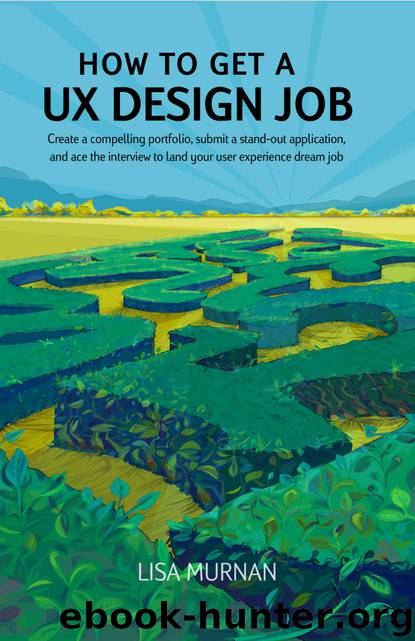How to Get a UX Design Job: Create a compelling portfolio, submit a stand-out application, and ace the interview to land your user experience dream job by Lisa Murnan

Author:Lisa Murnan [Murnan, Lisa]
Language: eng
Format: epub
ISBN: 9780988630444
Publisher: UX for the People
Published: 2018-02-22T07:00:00+00:00
Yay! Now you can take all the content from the robot resume and make it look nice for a human being again.
Your pretty resume should be clean and, well, pretty, but not over the top. It doesn’t need to show off all your mad UX skillzzz – that’s what your portfolio is for. While researching resumes for this book, I actually saw one where a UX designer put a giant pink unicorn graphic as a design element at the top of the page. Please don’t do that. You’ll stand out, for sure, but not in the right way.
I recently talked with a recruiter about resume formats and she said that she appreciated resumes that were visually pleasing and easy to scan. “Ironically,” she said, “sometimes the UX resumes are the hardest to navigate.” She said that charts that tried to visually show various skills and expertise were particularly confusing, and she recommended that candidates just provide a list of skills instead. She also said that she was seeing a lot more photos on resumes these days (especially from millennials), although photos “used to be a big no-no.” She said she just overlooks the photos now. (The way I interpret that is that including a photo on your resume isn’t doing a bit of good, and may even be hurting your chances.)
My pretty resume has a simple layout and minimal formatting. Since I’m old, I have a lot of content to cram on there, so I use the traditional resume format where the content takes up the whole width of the page and flows in sections from top to bottom. I’ve seen some resumes that divide the page up into two vertical columns (in a 2/3 to 1/3 ratio) – one column for job experience and the other for education information and lists of things like skills. This format is great for somebody who has less experience and needs to fill the page a bit.
I use a sans-serif font for the headers (including my name and contact info at the top) and a serif font for the body content. I use one accent color (blue) and it’s only for my name and the headers (Summary, Work Experience, etc.). The blue helps the headers pop out on the page without being too distracting.
I would only create customized versions of your pretty resume on a need-to-have basis – you won’t need one unless you make it past the ATS and get to talk to a real person. They may ask you to email them a copy, or if you get in for an interview you’ll want to bring printouts of your resume to hand out.
Make sure there are no discrepancies between the content in this resume and the ATS-friendly resume you already submitted.
Download
This site does not store any files on its server. We only index and link to content provided by other sites. Please contact the content providers to delete copyright contents if any and email us, we'll remove relevant links or contents immediately.
| Content Management | Programming |
| User Experience & Usability | User Generated Content |
| Web Design | Web Marketing |
| Web Services | Website Analytics |
The Mikado Method by Ola Ellnestam Daniel Brolund(12510)
Hello! Python by Anthony Briggs(12381)
Dependency Injection in .NET by Mark Seemann(11508)
The Well-Grounded Java Developer by Benjamin J. Evans Martijn Verburg(10003)
Secrets of the JavaScript Ninja by John Resig Bear Bibeault(9272)
Sass and Compass in Action by Wynn Netherland Nathan Weizenbaum Chris Eppstein Brandon Mathis(9137)
Svelte with Test-Driven Development by Daniel Irvine(8096)
Kotlin in Action by Dmitry Jemerov(7983)
Test-Driven Development with PHP 8 by Rainier Sarabia(7853)
Layered Design for Ruby on Rails Applications by Dementyev Vladimir;(7660)
Secrets of the JavaScript Ninja by John Resig & Bear Bibeault(7653)
Web Development with Django by Ben Shaw Saurabh Badhwar(7163)
React Application Architecture for Production by Alan Alickovic(6856)
Jquery UI in Action : Master the concepts Of Jquery UI: A Step By Step Approach by ANMOL GOYAL(6620)
Software Architecture for Web Developers by Mihaela Roxana Ghidersa(4955)
Audition by Ryu Murakami(4851)
Accelerating Server-Side Development with Fastify by Manuel Spigolon Maksim Sinik & Matteo Collina(4808)
Solidity Programming Essentials by Ritesh Modi(4533)
Hands-On Full-Stack Web Development with GraphQL and React by Sebastian Grebe(4413)
